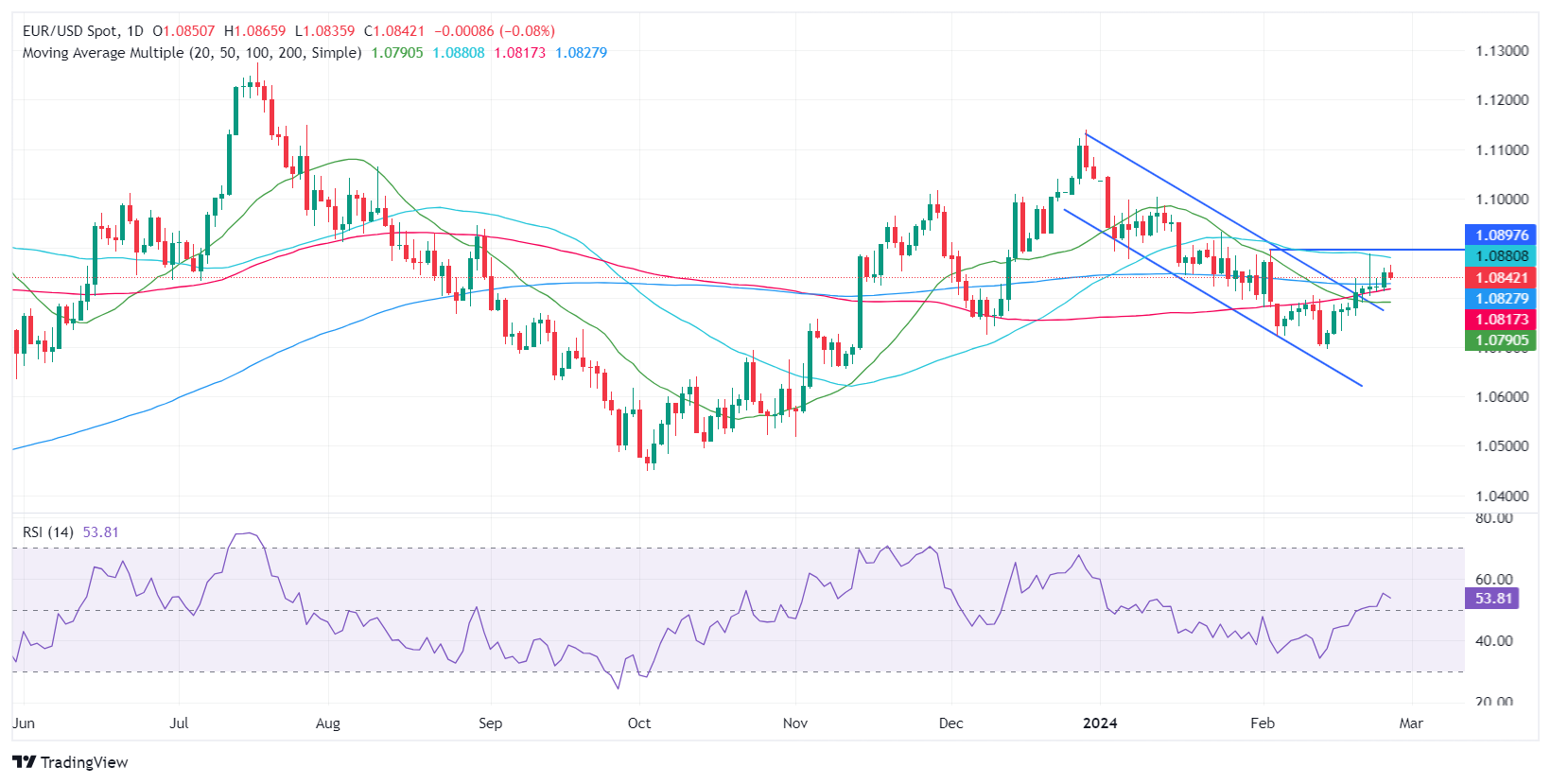- Phân tích
- Tin tức và các công cụ
- Tin tức thị trường
- EUR/USD slips amid risk-off sentiment despite US disappointing data
EUR/USD slips amid risk-off sentiment despite US disappointing data
- EUR/USD declines 0.12% as Wall Street losses and rising US Treasury yields bolster the Dollar amidst global caution.
- US economic reports reveal sharp drop in Durable Goods Orders and mixed signals from housing and business spending data.
- ECB's cautious stance on inflation and policy easing, coupled with weak Eurozone lending and German consumer sentiment, capped the Euro's advance.
The Euro registers losses versus the US Dollar early in the North American session, edges lower 0.12%, and trades at around 1.0837. A risk-off impulse, as witnessed by Wall Street’s posting losses and US Treasury bond yields rise, supports the Greenback’s recovery.
EUR/USD faces downward pressure as US economic indicators and ECB caution weigh on investor sentiment
Data-wise, the US economic docket featured Durable Goods Orders for January, which plunged more than the -4.5% contraction, down -6.1% MoM, below December’s -0.3% drop. Non-defense capital goods orders, excluding aircraft, used as a proxy for business spending, edged up 0.1% after a revised decline in December of -0.6%. Lately, housing data from the US, namely the S&P/Case Shiller Home Prices, edged lower -0.3% MoM in December, worse than November’s -0.2% contraction. Annually based figures edged up by 6.1%, exceeding estimates and the previous month’s data.
Across the pond, GfK revealed that German consumer sentiment stabilized at lower levels in March, coming at -29.0, a tick higher than February’s -29.7. Rolf Buerkl, consumer expert at the NIM noted “There is great uncertainty among consumers. In addition to the constantly rising prices, the weaker economic forecasts for the German economy this year are likely to be another important reason for this.”
At the same time, Eurozone (EU) lending halted in January, as the European Central Bank (ECB) reported that M3 annual growth was 0.1% less than estimates of 0.3%.
Recently, some European Central Bank (ECB) speakers, led by President Lagarde, had expressed that the inflation battle hasn’t been won. ECB’s Governing Council Stournaras said the ECB doesn’t have enough data on rate cuts until June, and when the time comes, the ECB will move gradually towards easing policy.
Ahead in the week, the EU’s docket will feature the Economic Sentiment Index. In the US, the second estimate of the Gross Domestic Product (GDP) and Fed speakers could spark some volatility in the EUR/USD pair.
EUR/USD Price Analysis: Technical outlook
Despite hitting a three-day high, the EUR/USD retreated from around 1.0860 to 1.0840s, at a time that Relative Strength Index (RSI) studies had peaked and edged towards the 50-midline. If sellers push the exchange rate below the 200-day moving average (DMA) at 1.0827, that would pave the way to test the 100-DMA at 1.0816, ahead of 1.0800. On the other hand, look for a re-test of the 50-DMA at 1.0881 before the 1.0900 figure.

© 2000-2024. Bản quyền Teletrade.
Trang web này được quản lý bởi Teletrade D.J. LLC 2351 LLC 2022 (Euro House, Richmond Hill Road, Kingstown, VC0100, St. Vincent and the Grenadines).
Thông tin trên trang web không phải là cơ sở để đưa ra quyết định đầu tư và chỉ được cung cấp cho mục đích làm quen.
Giao dịch trên thị trường tài chính (đặc biệt là giao dịch sử dụng các công cụ biên) mở ra những cơ hội lớn và tạo điều kiện cho các nhà đầu tư sẵn sàng mạo hiểm để thu lợi nhuận, tuy nhiên nó mang trong mình nguy cơ rủi ro khá cao. Chính vì vậy trước khi tiến hành giao dịch cần phải xem xét mọi mặt vấn đề chấp nhận tiến hành giao dịch cụ thể xét theo quan điểm của nguồn lực tài chính sẵn có và mức độ am hiểu thị trường tài chính.
Sử dụng thông tin: sử dụng toàn bộ hay riêng biệt các dữ liệu trên trang web của công ty TeleTrade như một nguồn cung cấp thông tin nhất định. Việc sử dụng tư liệu từ trang web cần kèm theo liên kết đến trang teletrade.vn. Việc tự động thu thập số liệu cũng như thông tin từ trang web TeleTrade đều không được phép.
Xin vui lòng liên hệ với pr@teletrade.global nếu có câu hỏi.















